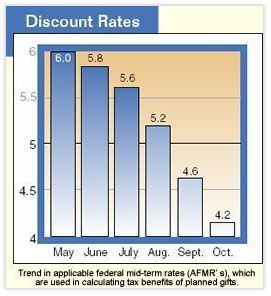As interest rates have fallen, many persons have enjoyed the benefits of lower mortgage, automobile financing, and other loan rates. Meanwhile, others have watched with dismay as their income from bank accounts, bonds, and other interest-sensitive investments continues to fall. This Catch-22 has affected many popular planned gifts as well. As the IRS discount rate used in the gift calculation process has fallen, charitable lead trusts and life estate agreements have become more attractive, while gift annuities and charitable remainder annuity trusts offer less and less appeal.
Based on the October IRS discount rate of 4.2%, the charitable deduction for both gift annuities and charitable remainder annuity trusts is lower than ever. This in turn can create problems in cases where the IRS-mandated gift calculation results in less than a 10% charitable deduction, or in cases in which there is a greater than 5% probability that the annuity trust ’s images will be depleted. For example, a 64-year- old couple can no longer establish a 5.5%annuity trust based on the October discount rate. A gift annuity established using the ACGA recommended rates would also fail. If the IRS discount rate continues to fall, increasing numbers of prospective donors will become affected by this problem.
Meanwhile, charitable lead trusts and life estate agreements may have never been more attractive from a tax-planning standpoint. Estate tax uncertainty and increasing real estate prices add to the appeal of these gift options. Individuals that had planned to leave substantial bequests to charity may find welcome income tax savings by instead deeding the remainder interest in a personal residence or farm to their favorite charity. Persons in the 70-75 age range might expect a current income tax deduction of between one-half and two-thirds of the current value of the property. The size of the deduction and the carry-forward provisions mean that donors may enjoy as many as six years of income tax savings from their gift!
Follow the leader
Wealthier individuals may wish to convert their bequest to a lead trust that will provide benefits for charity in the near term while ultimately providing a tax-favored inheritance for their loved ones.
Veteran gift planners will recall the excitement and interest caused by provisions in Jackie Onassis’s estate plan for the establishment of a charitable lead trust. The trust was designed to last for 24 years, with 8% annual payments to charity, before being returned to the family. The IRS discount rate in effect at the time of her death in 1994 resulted in a gift and estate tax deduction of over 99%, virtually eliminating those transfer taxes. This outcome was made possible by the low discount rate, the trust term, and the payout. Today, a lead trust like the Onassis trust is even more attractive because a similar outcome can be achieved over a shorter period of time with a lower payout. This will allow even greater flexibility in determining when the images will be returned to the family. For wealthy families, this option may now be more attractive than the traditional approach of establishing a family foundation.
If established today, a lead trust that pays just 7% for 22 years will result in no tax being due. If a longer time period is desired to ensure heirs are more mature, a similar outcome could be achieved by reducing the payout to 6.5% for 25 years, thereby achieving a deduction of 100%.
Utilizing gift and estate tax exemptions

Another powerful planning technique involves the use of the newly increased expansion equivalent to shelter any portion of the transfer left exposed. The gift and estate tax exemption equivalent was increased from $675,000 to $1,000,000 effective January 1, 2002. Even persons that had previously expended their available exemption equivalent now have an extra $325,000 available ($650,000 in the case of couples). This means that both the payout and trust term may be lowered, while still effecting a “zero tax transfer.” For example, a $1 million charitable lead trust could pay 6.1% per year for 15 years and result in no gift or estate tax liability.
Depending on an individual’s planning objectives, these gift planning options may be more attractive than ever for a growing number of prospects. Meanwhile, charitable remainder trusts and charitable gift annuities remain attractive for the 65+age segment, which constitutes the overwhelming majority of donors that have selected these options in the past.
As always, it is important to find the most effective strategies in any economic environment. Rather than focusing on the handicap low discount rates may create for some plans, capture this opportunity to generate interest in life-estate agreements and lead trusts among your donors. You and your donors may be very glad you did.

